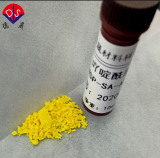Chinese VersionChina Suppliers > Hubei new DE sheng material science and technology co., LTD. > How to label antibodies with the luminescent marker acridine ester (NSP-SA-NHS)
- Search Product
-
-
- Region :China/Hubei
- Tel : +86-18971041571
- Fax :
- Email :vickyzhao@whdschem.com
- URL :
- Add :Guanggu United Science and Technology City C8, Ezhou City, Hubei Province
- Details for How to label antibodies with the luminescent marker acridine ester (NSP-SA-NHS)
-
How to label antibodies with the luminescent marker acridine ester (NSP-SA-NHS)
Category : Other Chemicals/Others

CAS NO : Cas199293-83-9 EC NO : MF : MW : Specification : yellow powder. Packing : 10mg/bottle Product description : Acridine ester (NSP-SA-NHS), Cas199293-83-9, and its related compounds have been proven to be highly advantageous chemiluminescent markers, with stability, activity, and sensitivity exceeding that of certain radioactive isotopes. Acridine ester can react with proteins containing primary amino groups. Under alkaline conditions, NHS is replaced as a leaving group, and the protein forms stable amide bonds with acridine esters. After the reaction is completed, the excess acridine salt is removed through a desalination column. Below are instructions for using NSP-SA-NHS (such as antibody/protein labeling). 1. Preparation Labeling buffer: 0.2M NaHCO3 (pH=9.0); Labeling termination buffer: 10% lysine 0.2M NaHCO3 (pH=9.0) solution; Desalination purification buffer: 0.1M Na2HPO4-NaH2PO4 (pH=6.5); Acridine ester luminescent solution: (0.01-0.1M) NaOH+0.05% H2O2. 2. Calculate the amount of antibody (protein) and acridine ester used for labeling: Usually, the molar ratio n (antibody): n (acridine ester) is set to be 1:10-1:50, which needs to be adjusted according to the amino acid composition; Prepare 2.5mg/ml acridine ester DMSO mother liquor, pay attention to glass containers and avoid light; Prepare 0.1-0.5 mg/ml antibody reaction solution using 0.2M NaHCO3 (pH=9.0) solution. Uses : Chemiluminescence reagent Synonyms : no data
- more>>Other Products
-
- • Biological buffer 3- [N, N-di (hydroxyethyl) amino] -2-hydroxypropanesulfonic acid DIPSO
- • Luminol Sodium Salt
- • 4-Aminophthalhydrazide
- • acridinium ester DMAE-NHS
- • acridinium ester NSP-DMAE-NHS
- • Acridine hydrochloride NSP-SA
- • Acridine hydrochloride NSP-SA-NHS
- • NSP-SA-ADH
- • acridinium ester ME-DMAE-NHS TOOS; 3-(N-Ethyl-3-Methylanilino)-2-Hydroxypropanesulfonic Acid Sodium Salt
- • TOPS; Sodium 3-(N-Ethyl-3-Methylanilino)Propanesulfonate; N-Ethyl-N-Sulfopropyl-M-Toluidine Sodium Salt
- • ADOS Sodium 3-(Ethyl(3-Methoxyphenyl)Amino)-2-Hydroxypropane-1-Sulfonate Dihydrate
- • ADPS N-Ethyl-N-(3-Sulfopropyl)-3-Methoxyaniline Sodium Salt
- • ALPS N-Ethyl-N-(3-Sulfopropyl)Aniline Sodium Salt; Sodium 3-(Ethyl(Phenyl)Amino)Propane-1-Sulfonate; Sodium
- • DAOS; Sodium 3-((3,5-Dimethoxyphenyl)(Ethyl)Amino)-2-Hydroxypropane-1-Sulfonate
- • HDAOS; N-(2-Hydroxy-3-Sulfopropyl)-3,5-Dimethoxyaniline Sodium Salt
- • MADB N,N-Bis(4-Sulfobutyl)-3,5-Dimethylaniline Disodium Salt
- • MAOS N-Ethyl-N-(2-Hydroxy-3-Sulfopropyl)-3,5-Dimethylaniline Sodium Salt Monohydrate
- • DAB 3,3',4,4'-Biphenyltetramine Tetrahydrochloride